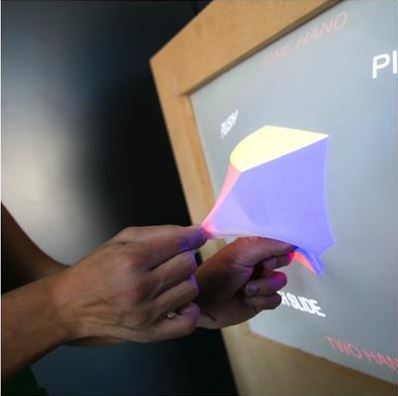Right now, that's just in an Avengers movie. Instead, we live in a world of flat-screen displays, even though the real world is not flat, it has hills and valleys, people and objects. Being able to manipulate a display and drag features into a 3-D world is the purpose of GHOST (Generic, Highly-Organic Shape-Changing Interfaces), an EU research project designed to tap humans’ ability to reason about and manipulate physical objects through the interfaces of computers and mobile devices.
"This will have all sorts of implications for the future, from everyday interaction with mobile phones to learning with computers and design work," says GHOST coordinator Professor Kasper Hornbæk of the University of Copenhagen. "It’s not only about deforming the shape of the screen, but also the digital object you want to manipulate, maybe even in mid-air. Through ultrasound levitation technology, for example, we can project the display out of the flat screen. And thanks to deformable screens we can plunge our fingers into it."

© GHOST
This breakthrough in user interaction with technology allows us to handle objects, and even data, in a completely new way. A surgeon, for instance, will be able to work on a virtual brain physically, with the full tactile experience, before performing a real-life operation. Designers and artists using physical proxies such as clay can mold and re-mold objects and store them in the computer as they work. GHOST researchers are also working with deformable interfaces such as pads and sponges for musicians to flex to control timbre, speed and other parameters in electronic music.
GHOST has produced an assembly line of prototypes to showcase shape-changing applications. ‘Emerge’ is one which allows data in bar charts to be pulled out of the screen by fingertips. The information, whether it’s election results or rainfall patterns, can then be re-ordered and broken down by column, row or individually, in order to visualize it better. The researchers have also been working with ‘morphees’, flexible mobile devices with lycra or alloy displays which bend and stretch according to use. These can change shape automatically to form screens to shield your fingers when you type in a pincode, for example, or to move the display to the twists and turns of a game. And such devices can be enlarged in the hand to examine data closer and shrunk again for storing away in a case or pocket.
One of the GHOST partners, the University of Bristol, has spun off a startup, now employing 12 people, called UltraHaptics, to develop technology being studied in GHOST that uses ultrasound to create feeling in mid-air. The company has attracted seed investment in the UK and further funding from the Horizon 2020 program.





Comments